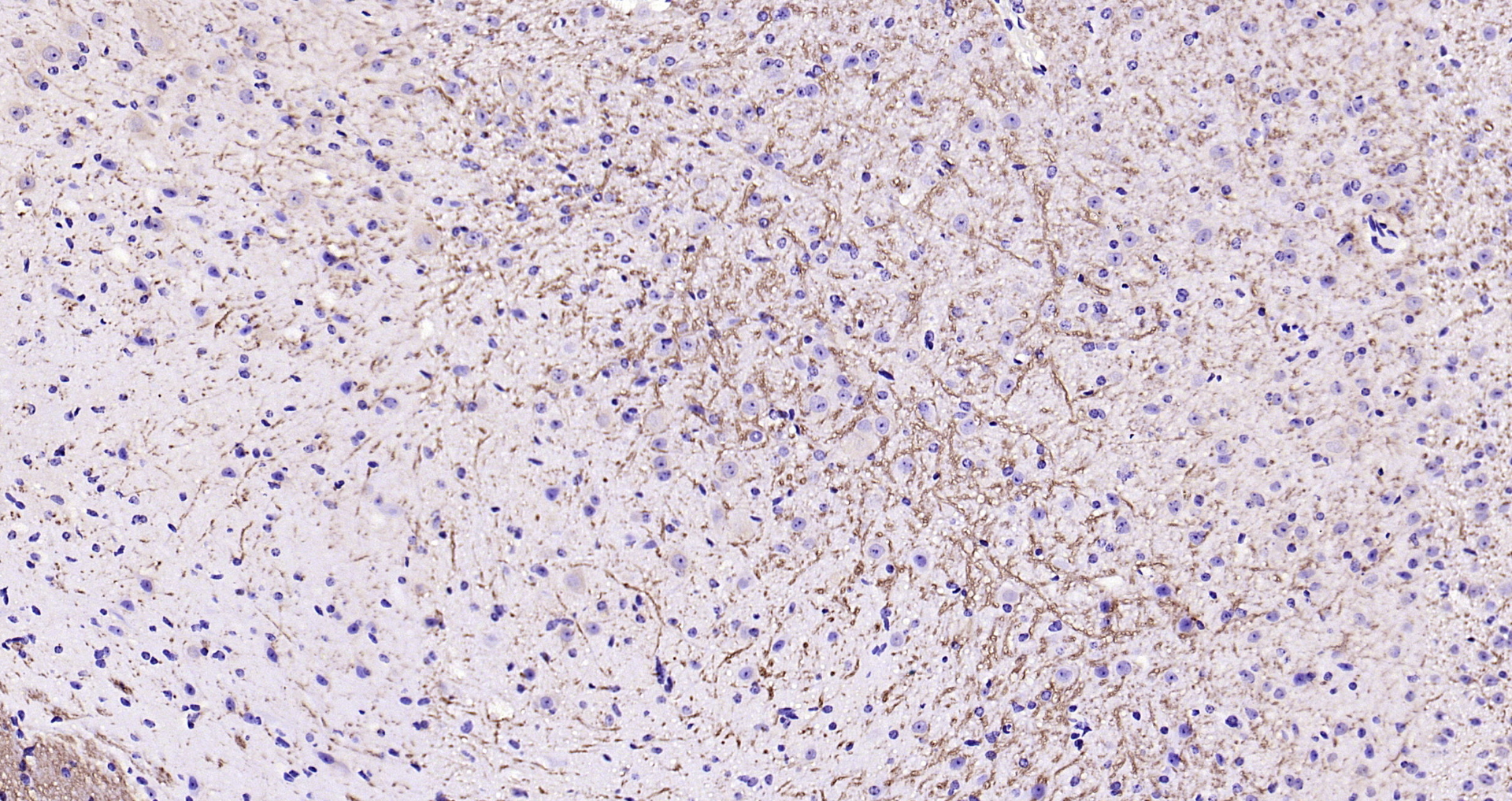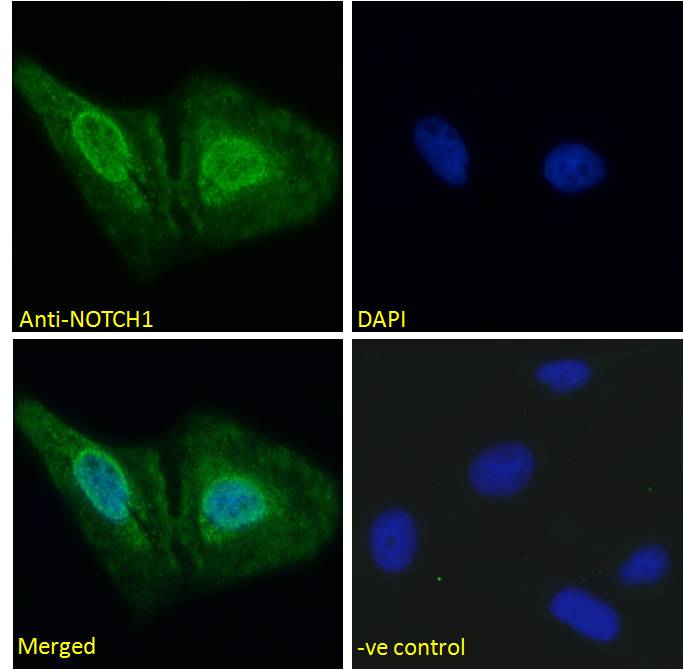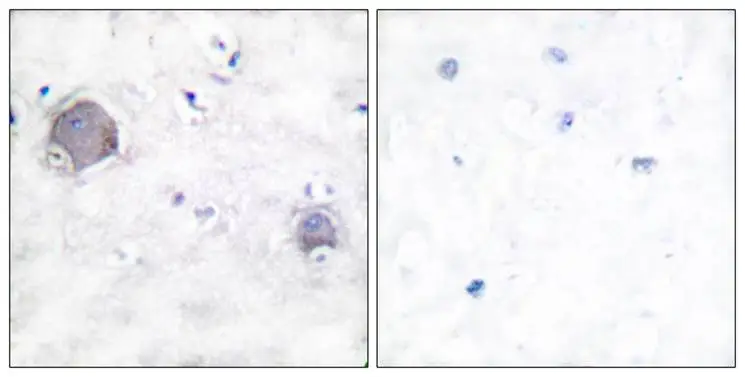![IHC-P analysis of colon adenocarcinoma tissue using GTX84020 NOTCH1 antibody [4C9]. Antigen retrieval : Heat-induced epitope retrieval by 10mM citrate buffer, pH6.0, 100oC for 10min. Dilution : 1:50 IHC-P analysis of colon adenocarcinoma tissue using GTX84020 NOTCH1 antibody [4C9]. Antigen retrieval : Heat-induced epitope retrieval by 10mM citrate buffer, pH6.0, 100oC for 10min. Dilution : 1:50](https://www.genetex.com/upload/website/prouct_img/normal/GTX84020/GTX84020_2178_IHC-P_w_23061420_888.webp)
IHC-P analysis of colon adenocarcinoma tissue using GTX84020 NOTCH1 antibody [4C9]. Antigen retrieval : Heat-induced epitope retrieval by 10mM citrate buffer, pH6.0, 100oC for 10min. Dilution : 1:50
NOTCH1 antibody [4C9]
GTX84020
ApplicationsWestern Blot, ImmunoHistoChemistry, ImmunoHistoChemistry Paraffin
Product group Antibodies
TargetNOTCH1
Overview
- SupplierGeneTex
- Product NameNOTCH1 antibody [4C9]
- Delivery Days Customer9
- Application Supplier NoteWB: 1:1000. IHC-P: 1:50-1:150. *Optimal dilutions/concentrations should be determined by the researcher.Not tested in other applications.
- ApplicationsWestern Blot, ImmunoHistoChemistry, ImmunoHistoChemistry Paraffin
- CertificationResearch Use Only
- ClonalityMonoclonal
- Clone ID4C9
- Concentration1 mg/ml
- ConjugateUnconjugated
- Gene ID4851
- Target nameNOTCH1
- Target descriptionnotch receptor 1
- Target synonymsAOS5, AOVD1, TAN1, hN1, neurogenic locus notch homolog protein 1, Notch homolog 1, translocation-associated, notch 1, translocation-associated notch protein TAN-1
- HostMouse
- IsotypeIgG2b
- Protein IDP46531
- Protein NameNeurogenic locus notch homolog protein 1
- Scientific DescriptionFunctions as a receptor for membrane-bound ligands Jagged1, Jagged2 and Delta1 to regulate cell-fate determination. Upon ligand activation through the released notch intracellular domain (NICD) it forms a transcriptional activator complex with RBP-J kappa and activates genes of the enhancer of split locus. Affects the implementation of differentiation, proliferation and apoptotic programs. May be important for normal lymphocyte function. In altered form, may contribute to transformation or progression in some T-cell neoplasms. Involved in the maturation of both CD4+ and CD8+ cells in the thymus. May be important for follicular differentiation and possibly cell fate selection within the follicle. During cerebellar development, may function as a receptor for neuronal DNER and may be involved in the differentiation of Bergmann glia.
- Storage Instruction-20°C or -80°C,2°C to 8°C
- UNSPSC12352203

![IHC-P analysis of human endometrium adenocarcinoma tissue using GTX84020 NOTCH1 antibody [4C9]. IHC-P analysis of human endometrium adenocarcinoma tissue using GTX84020 NOTCH1 antibody [4C9].](https://www.genetex.com/upload/website/prouct_img/normal/GTX84020/GTX84020_2179_IHC-P_w_23061420_108.webp)
![IHC-P analysis of human ovary adenocarcinoma tissue using GTX84020 NOTCH1 antibody [4C9]. Antigen retrieval : Heat-induced epitope retrieval by 10mM citrate buffer, pH6.0, 100oC for 10min. Dilution : 1:50 IHC-P analysis of human ovary adenocarcinoma tissue using GTX84020 NOTCH1 antibody [4C9]. Antigen retrieval : Heat-induced epitope retrieval by 10mM citrate buffer, pH6.0, 100oC for 10min. Dilution : 1:50](https://www.genetex.com/upload/website/prouct_img/normal/GTX84020/GTX84020_2180_IHC-P_w_23061420_222.webp)
![IHC-P analysis of breast tissue using GTX84020 NOTCH1 antibody [4C9]. Antigen retrieval : Heat-induced epitope retrieval by 10mM citrate buffer, pH6.0, 100oC for 10min. Dilution : 1:50 IHC-P analysis of breast tissue using GTX84020 NOTCH1 antibody [4C9]. Antigen retrieval : Heat-induced epitope retrieval by 10mM citrate buffer, pH6.0, 100oC for 10min. Dilution : 1:50](https://www.genetex.com/upload/website/prouct_img/normal/GTX84020/GTX84020_2181_IHC-P_w_23061420_384.webp)
![IHC-P analysis of kidney carcinoma tissue using GTX84020 NOTCH1 antibody [4C9]. Antigen retrieval : Heat-induced epitope retrieval by 10mM citrate buffer, pH6.0, 100oC for 10min. Dilution : 1:50 IHC-P analysis of kidney carcinoma tissue using GTX84020 NOTCH1 antibody [4C9]. Antigen retrieval : Heat-induced epitope retrieval by 10mM citrate buffer, pH6.0, 100oC for 10min. Dilution : 1:50](https://www.genetex.com/upload/website/prouct_img/normal/GTX84020/GTX84020_2182_IHC-P_w_23061420_542.webp)
![IHC-P analysis of lung carcinoma tissue using GTX84020 NOTCH1 antibody [4C9]. Antigen retrieval : Heat-induced epitope retrieval by 10mM citrate buffer, pH6.0, 100oC for 10min. Dilution : 1:50 IHC-P analysis of lung carcinoma tissue using GTX84020 NOTCH1 antibody [4C9]. Antigen retrieval : Heat-induced epitope retrieval by 10mM citrate buffer, pH6.0, 100oC for 10min. Dilution : 1:50](https://www.genetex.com/upload/website/prouct_img/normal/GTX84020/GTX84020_2183_IHC-P_w_23061420_298.webp)
![IHC-P analysis of pancreas carcinoma tissue using GTX84020 NOTCH1 antibody [4C9]. Antigen retrieval : Heat-induced epitope retrieval by 10mM citrate buffer, pH6.0, 100oC for 10min. Dilution : 1:50 IHC-P analysis of pancreas carcinoma tissue using GTX84020 NOTCH1 antibody [4C9]. Antigen retrieval : Heat-induced epitope retrieval by 10mM citrate buffer, pH6.0, 100oC for 10min. Dilution : 1:50](https://www.genetex.com/upload/website/prouct_img/normal/GTX84020/GTX84020_2184_IHC-P_w_23061420_841.webp)
![IHC-P analysis of thyroid carcinoma tissue using GTX84020 NOTCH1 antibody [4C9]. Antigen retrieval : Heat-induced epitope retrieval by 10mM citrate buffer, pH6.0, 100oC for 10min. Dilution : 1:50 IHC-P analysis of thyroid carcinoma tissue using GTX84020 NOTCH1 antibody [4C9]. Antigen retrieval : Heat-induced epitope retrieval by 10mM citrate buffer, pH6.0, 100oC for 10min. Dilution : 1:50](https://www.genetex.com/upload/website/prouct_img/normal/GTX84020/GTX84020_2185_IHC-P_w_23061420_484.webp)
![IHC-P analysis of endometrium tissue using GTX84020 NOTCH1 antibody [4C9]. Antigen retrieval : Heat-induced epitope retrieval by 10mM citrate buffer, pH6.0, 100oC for 10min. Dilution : 1:50 IHC-P analysis of endometrium tissue using GTX84020 NOTCH1 antibody [4C9]. Antigen retrieval : Heat-induced epitope retrieval by 10mM citrate buffer, pH6.0, 100oC for 10min. Dilution : 1:50](https://www.genetex.com/upload/website/prouct_img/normal/GTX84020/GTX84020_2186_IHC-P_w_23061420_125.webp)
![IHC-P analysis of human bladder tissue using GTX84020 NOTCH1 antibody [4C9]. IHC-P analysis of human bladder tissue using GTX84020 NOTCH1 antibody [4C9].](https://www.genetex.com/upload/website/prouct_img/normal/GTX84020/GTX84020_2187_IHC-P_w_23061420_168.webp)






![IHC-P analysis of breast adenocarcinoma tissue using GTX84019 NOTCH1 antibody [3E12]. Antigen retrieval : Heat-induced epitope retrieval by 10mM citrate buffer, pH6.0, 100oC for 10min.](https://www.genetex.com/upload/website/prouct_img/normal/GTX84019/GTX84019_2164_IHC-P_w_23061420_289.webp)
